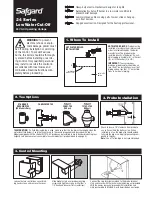
44 / 72
Putting out of operation
V 1.0
8
Putting out of operation
8.1
Putting out of operation temporarily
With this type of switch-off, the machine remains installed and is not disconnected from the mains power supply.
When out of operation temporarily, the pump must remain completely submersed so that it is protected from frost
and ice. It must be guaranteed that the service room and pumping medium do not freeze completely. The machine
is then ready for operation at any time. Following longer periods of standstill, a 5-minute function run should be
carried out at regular intervals (once a month to once every three months).
Caution!
A functional run may only take place under valid operating and usage conditions. Dry running is not permitted.
Disregarding these facts can lead to total failure.
8.2
Putting out of operation finally/ putting in storage
Switch off the machine, disconnect the machine from the mains power supply and put it in storage. The following
points must be taken into particular consideration for the storage procedure:
Beware of hot parts!
Watch the temperature of the housing parts when removing the machine. These can be far above 40°C. Always
allow the machine to cool to ambient temperature first.
• Clean the machine.
• Store in a clean and dry location, protect the machine from frost.
• Set down vertically on a firm base and secure it from falling over.
• The discharge and suction connection of pumps must be sealed using suitable aids (e.g. film).
• Support the electrical connection cable at the cable ducts to prevent permanent deformation.
• Protect the ends of the power supply cables to prevent humidity penetration.
• Protect the machine from direct sunlight to prevent the danger of elastomer parts and housing coating
becoming brittle.
• When storing in a workshop, heed the following: The radiation and gases which occur during electro-welding
destroy the elastomers of the seals.
• During longer storage periods, the impeller or the propeller must be turned regularly by hand (every six
months). This prevents pressure marks in the bearings and seizure of the rotor.
8.3
Putting back into service after longer periods of storage
Before it is put back into service, the machine must be cleaned of dust and oil deposits. Then all the necessary
maintenance measures and work must be carried out (see chapter “Regular maintenance”). The floating-ring type
shaft seal must be checked for proper condition and function. When this work is finished, the machine can be
installed (see chapter “Set-up”) and connected to the mains power supply by a specialist. Follow the instructions
in the chapter “Putting into operation” when putting the machine back into operation.
The machine may only be switched on again if it is in a perfect condition and ready for operation.
Summary of Contents for Aqualift F XXL 400 litres 50 Hz Series
Page 49: ...KESSEL Aqualift F XXL 400 KESSEL Aqualift F XXL 800 50 Hz 2016 11 010 985 SDS 100...
Page 53: ...53 72 V 1 0 1 2 KESSEL 1 3 KESSEL 1 4 www kessel de 1 4 1 1 4 2 KESSEL 1 4 3 KESSEL KESSEL...
Page 55: ...55 72 V 1 0 2 2 1 DIN ANSI 2 2 CE EC EC VDE CE 2 3...
Page 56: ...56 72 V 1 0 2 4 2 5 2 5 1 EMC 2 5 2 IP 68 2 6...
Page 57: ...57 72 V 1 0 2 7 2 8 2 9 kW 40dB A 70dB A...
Page 59: ...59 72 V 1 0 4 4 1 4 2 4 3...
Page 61: ...61 72 V 1 0 1 1 5 3 5 4...
Page 63: ...63 72 V 1 0 5 9 5 2 5 1...
Page 64: ...64 72 V 1 0 6 6 1 BGV GUV 75 439 EWG AbfG 5a 5B TA 524 02 EC 91 689 EEC 6 2 3000 8000 2...
Page 65: ...65 72 V 1 0 6 3 3 KESSEL KESSEL 0 1 3 4...
Page 67: ...67 72 V 1 0...
Page 68: ...68 72 V 1 0 8 8 1 5 8 2 40 8 3...
Page 69: ...69 72 V 1 0 9...
Page 70: ...70 72 V 1 0 2 2 KESSEL...
















































